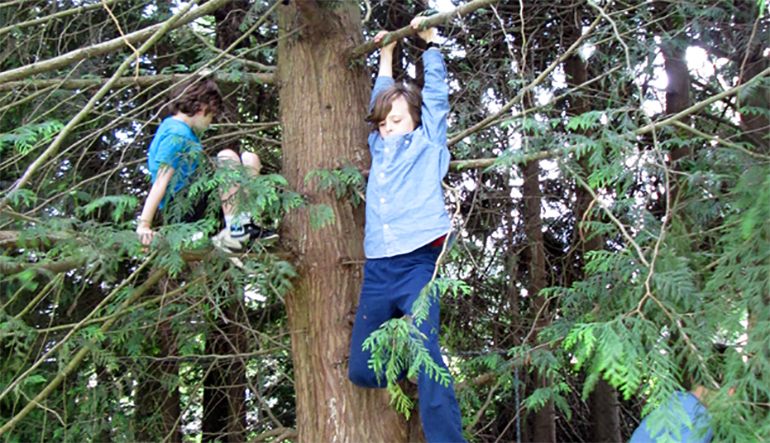
One of the best ways to refresh your children is to encourage free-form healthy active outdoor play.
Originally published in the summer issue of Fraser Health's Healthier You magazine.
On a recent Saturday, my friend and I took our sons to our local playground in North Burnaby. With our tea mugs in hand and two 11-year-olds, an eight-year-old and a five-year-old in tow, we found a bench so we could visit and catch-up after another busy week.
The three older boys immediately asked if they could search for evidence of a werewolf over in the treed area, beyond our field of vision. By this time, the five-year-old was already off on his own climbing on the playground equipment and finding new friends. Sure. Fine. Stick together – what direction are you going? Check in with us later....
Was this bad parenting? Should we have kept the older boys in sight at all times? Should we have gone with them to make sure they didn’t get into mischief? Should we have been shadowing the movements of the youngest child as he explored the playground equipment, ready to jump the minute we thought he needed help?
If you’re a parent you probably ask yourself these kinds of questions all time.
Some would say that, yes, we were being bad parents. You are probably aware of the term ‘helicopter parents’, so named because they hover over their children waiting to swoop in and rescue them as soon as a problem arises. ‘Snowplough parents’ take this over-protectiveness to a new level – they don’t let problems arise in the first place, clearing away all obstacles to ensure their children never encounter any difficulties.
Other parents would probably side with us, or maybe add an ‘it depends’.
My friend and I were clearly not hovering or snowploughing. As a parent of two active boys, I look for healthy ways to fill their days. As a researcher in injury prevention, I prefer to go to work without having to confess how one of my family members has personally contributed to our injury data.
When I am concerned about letting my boys go, I try to consider this question: What impact might my over-protectiveness have when they head into the world alone and inevitably meet problems there?
I think all parents need to consider this question when pondering what their children are and are not allowed to do on their own.
Risk-taking can be healthy
Compared to their parents’ childhood, today’s children are much less likely to get out and play and are more likely to be in front of screens and/or in organized activities that require them to be chauffeured around. It has been reported that time spent engaged in active play declined by 25 per cent between 1981 and 1997 among children ages six to eight years old.
We need to get over the idea that our children should be wrapped in protective layers of cotton wool. Yes, it may protect them, but it will likely stifle them in the process. Even structured playgrounds stifle their imaginations: take your turn to go up the ladder, then go down the slide.
Playing outside should involve risk, not hazard. A risk is something a child can understand, make decisions about and learn from – Is the stream too wide to jump? Will my feet get wet? A hazard is something hidden and potentially dangerous, like broken glass near the stream. As parents, our job is to minimize the hazards while providing opportunities to encounter healthy risks.
Unstructured play enables children to use their imaginations. It provides them with opportunities to interact with other children, to encounter new situations, to solve problems and to gain confidence. Play should be exciting – running fast, climbing high and chasing monsters. Play should challenge our children to test their limits, find their comfort zone and explore something new.
Support free play
Living in the Lower Mainland of British Columbia provides a lot of opportunities to get outside. Kids can wander their neighbourhood, go to the park or explore a hiking trail. With their family they can head to a lake or the ocean to discover what they’ll find on rocky shorelines and beaches. They can roam hills and mountains, trees and forests.
Mine is a fairly typical family – I think. We have successfully negotiated through the toddler years and are starting to enjoy our boys gaining some independence. We limit our children’s television and computer time to about three hours a week, mostly on weekends. Instead of sitting around, my children and their friends are encouraged to be outside roaming the neighbourhood on their bikes, digging in ditches searching for rocks, and getting muddy. I am not a big fan of the soaked shoes, but the excited descriptions of their adventures are much more appealing than trying to drag a snarling boy away from a video game.
And yes, some injuries will happen. I routinely have to deal with scrapes and bumps, and there was that broken collarbone last fall. Don’t worry, it healed well and my son is now trying to persuade his school principal to loosen up on the schoolyard rules so students can explore their own ways to play.
This summer, let your children go outside to play.
